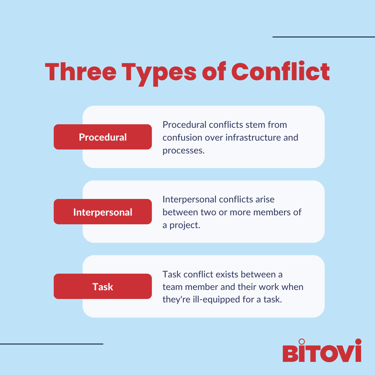In This Series: Conflict-Free Leadership
Your team has defined roles, attainable and measurable goals, and clear expectations. So why is there still conflict?
In part one, you learned about the importance of clear communication and how it can prevent conflict. However, just because you've established roles, goals, and expectations doesn't mean your team will never experience conflict.
This post is here for when conflicts arise. We will cover different types of conflict, how to prevent them, and how to resolve them quickly when they arise.
Types of Conflict

It's crucial to keep in mind that conflict is not inherently bad. Conflict can lead to creative problem-solving or provide an opportunity to reflect and enhance your processes.
Conflict has a bad reputation because it has the potential to take time and resources away from the project at large, leading to an increase in frustration and a decrease in productivity. The key to preventing this toil is understanding the different types of conflict.
Today, you'll learn about the three most common types of project-related conflict: procedural, interpersonal, and task conflict. Then, you'll gain insight into how setting clearer roles, goals, and expectations can mitigate conflict and enhance our team's problem-solving ability.
Procedural Conflicts
Procedural conflicts stem from confusion over infrastructure and processes. In other words, procedural conflicts are often a direct result of a breakdown in how we do our work or how our work is delivered. Let's look at a real-life example of procedural conflict from my days as a junior dev.
I had just started as a junior developer and was assigned to a new project. I was introduced to the project management software the team used to track progress and divvy tasks, but I didn't have a clear sense of when to commit my code or who would review merge requests.
Excited to prove myself, I worked hard to complete all my assigned tasks and was proud of my work. At the Friday stand-up, I was eager to give a full report of my work and ask for a few more assignments. When Friday's stand-up rolled around, the team lead addressed me first, and it went a little something like this:
Team Lead: “I haven’t seen anything from you all week. What are you stuck on?”
Me: “I’m not stuck. I completed everything on my task list but wasn’t sure when to commit my code.”
Team Lead: “You develop, run your tests, and commit after each task. Otherwise, we’re increasing the chance of merge conflicts. Let’s have you commit what you’ve done so far.”
This exchange left me feeling deflated. From my vantage point, I'd done everything I was assigned, and I'd been excited to share my work with the team. Instead, from my team lead's perspective, I'd missed a crucial step and left everyone wondering what I'd spent my week doing.
After stand-up, I committed my changes and waited to hear from the team lead to review the merge request. I hadn't been assigned anything new, so I spent the rest of the day waiting.
Eventually, the merge request was approved, and nothing catastrophic came from the unclear procedures. But as a new developer, my confidence was shaken, and I lost a day of work waiting on another team member.
Scenarios like this are all too familiar. While procedural conflict isn't always detrimental to the final product, it shakes the team's foundation and, over time, can contribute to low morale and a general sense of frustration.
I find procedural conflict especially detrimental to developers. Developers are excited to do their work! They want to find solutions and contribute as much as possible, but their ability to contribute is directly impacted by how well their leaders communicate. Leaders must clearly communicate their team’s roles, goals, and expectations to prevent this conflict.
Workflow communication breakdowns can hinder progress and impede the flow of information. We often see a high level of this conflict type at the outset of a project, and it gradually declines as the organization begins to take shape.
But rather than barreling into a project, hoping the snags work themselves out organically, clear processes laid out before the start of a project will decrease instances of miscommunication and ensure everyone on the team is confident in what they're doing and how it gets delivered.
Interpersonal Conflicts
Interpersonal conflicts arise between two or more members of a project. These scenarios often present because each team member brings unique perspectives, varying areas of expertise, and personality differences.
Think about a time when you clashed with a co-worker during a big project. How much time did you spend thinking about the conflict instead of your work? Did the conflict lead to above-average levels of stress? Do you remember that project with a sense of negativity even if the work turned out okay? Interpersonal conflicts are normal, but when a project is eclipsed by butting heads and awkward meetings, there is room for improvement.
It’s important to examine why interpersonal conflicts flare up. Are you assigning the right people the right roles? Have you set up proper channels for open communication? Has the workflow been laid out in detail for everyone involved in the project? By anticipating potential issues, leadership will be better equipped to preempt interpersonal conflict or provide healthy channels for its resolution.
Proper lines of communication can help deescalate tense situations quickly, preventing them from turning into full-blown conflicts. For instance, if someone fails to complete an assigned task and their co-worker is concerned, the co-worker should feel free to go directly to the source of the incomplete work. They may ask if their co-worker needs assistance or if they have an estimate of when the work will be completed. If your team knows who’s doing which task and can go directly to the source when something is incomplete, it makes space for conversation. Perhaps their co-worker forgot about that task and didn’t realize they were holding up the project. Maybe they misread the due date or are stuck on the issue but don’t know who to ask for help. Better yet, what if you cultivate a work environment where everyone feels empowered to throw their questions into the #ask-help Slack channel, knowing their teammates will jump in to help without judgment?
The likelihood of a team member not contributing for no reason at all is low. With the transparency of roles and open communication, it becomes easier for team members to go directly to the source or ask for help, resolving the issue before it becomes a hindrance to the overall project.
It’s also important to remember that interpersonal conflict can be the result of passionate people advocating for what they feel is best for the project. Embrace that kind of conflict and allow it to perpetuate an environment of colleagues who are willing to engage in healthy debates - that’s where good ideas become great!
Establishing a community of transparency and open communication prevents an issue from festering and infecting the whole team or multiple aspects of the project. Instead, let passion empower your team to collaborate and discover creative solutions.
Task Conflicts
Task conflicts can lead to creative problem-solving, but they also open up teams to feelings of defeat and frustration. As leaders, it’s important we give our team the tools they need from the outset - set them up for success. Of course, this can mean physical tools like computers, software, continuing education stipends, or online resources. But, equally as important is assurance that if a team member is struggling or feels under-prepared to complete a task, there’s a clear path to help.
We’ve all encountered that quiet co-worker who would rather scour the internet for hours in search of a solution rather than throw a question into the Slack channel and ask for a lifeline. Having self-sufficient team members is a huge benefit, but everyone is fallible. There may come a day when that team member cannot find the answer or is working against a tight deadline and doesn’t have time for their normal deep dive. Ensuring all team members have a point person, Slack channel, or daily stand-up where they can freely ask questions and receive the necessary support strengthens the team. Knowing that no one person has all the answers and that there is a consistent resource to seek help maintains the desired work cadence and helps ensure a high quality of work is delivered.
It’s wonderful to maximize individual performance, and that should be encouraged. We should not forget, however, that projects are done in teams for a reason. To get the most out of your team, set up a scaffold of support so everyone knows there are options should they need them.
Implementation of the roles, goals, and expectations framework at the inception of a project can minimize procedural, interpersonal, and task conflict. Reducing procedural conflict reduces the likelihood of interpersonal conflicts, as they often stem from miscommunications, and improved communication and trust can help teams efficiently tackle task conflicts.
Conflict Solutions: Focus on Processes, Not People
Have you ever been called into a meeting during which your infuriated boss chastised employees for not being finished with a project? Or skipping a step? Or reaching out to the wrong person with a question? Did you sit there and wonder why no clear deadline had been set? Or why ordered steps hadn’t been laid out from the beginning? Or simply thinking - I would have done that if only the expectations had been clear.
We’ve all seen or heard of higher-ups who run their meetings like they’re the coach of the losing team at halftime. But that is not the way to galvanize employees to perform, and that isn’t a healthy working environment for anyone.
We often locate problems in people when the hard truth is that issues stem from poor organization. Managing processes is a far more effective means of retaining good people and reducing the chance of serious conflict. But it will take effort! Giving yourself those hours of pre-planning and laying out specific roles for each team member, goals for the project, and expectations for the quality of work, protects you from headaches down the line. Quality processes leave less room for guesswork and open lines of communication among the team, ensuring that delivering a quality product on time remains at the forefront.
Understanding that conflicts are usually the symptom of a much larger breakdown in the process can also help formulate better questions from the beginning. Instead of “Why is our engineering team so reluctant to translate existing code into this new, more flexible programming language?” the question becomes, “How does this application's monolithic architecture make it challenging to switch to a newer, more flexible programming language?” Now, we’ve located the conflict in the application's architecture as opposed to the team of engineers. By assessing the real root cause of an issue, we are more likely to find long-term solutions.
While it may be impossible or even ill-advised to prevent conflict entirely, the objective is to anticipate the sources of potential conflict and implement practices to mitigate them, prioritizing the discovery of more permanent solutions.
Conclusion: Moving Past Conflict
While setting clear roles, goals, and expectations is essential to prevent conflict, it's not always enough to keep it from happening. Conflict can arise from procedural, interpersonal, or task-related issues, and it's crucial to understand the root cause to address it effectively.
Emotional intelligence is also critical in resolving conflicts. Being aware of one's emotions and being able to manage them in a constructive way can prevent conflicts from escalating and help find a solution that works for everyone. It's also essential to be empathetic and considerate of others' feelings and perspectives, which can help de-escalate tense situations and find a mutually beneficial resolution.
In the next post, we will delve into the role of emotional intelligence in resolving conflicts. By honing your emotional intelligence skills, you'll be better equipped to navigate conflicts when they arise and maintain a positive and productive work environment.



